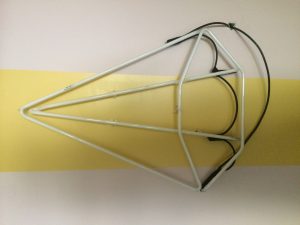Is Neon Explosive?

Neon is one of the inert gases within the Periodic Table. It means that this element is chemically inactive and will not react to any other element. When it comes to exploding, the answer is relative.
Given that Neon is nonreactive, it can’t explode itself. There are cases when encountering failure like burning up due to insulation failures.
To ensure safety, you need to check for the transformer’s condition. Don’t plug it until an electrician examines it. Old transformers can produce dangerous high-voltage shocks. Also, no matter how new your neon sign or neon light is, always unplugging the transformer during maintenance checks is advisable.
How do Neon Lights work?
Glass tubes filled with a combination of neon and argon gas make up a neon sign. Gases like helium, neon, and argon never chemically bind with other atoms to form stable molecules. It will continue to shine when a slight electric voltage is applied to the electrodes at the ends of the glass tubing that holds the inert gas. When an atom’s electron is excited, a gas discharge emits light.
When an electron is excited, it has a higher-energy orbital. When it returns to its initial orbital, a photon takes away the energy, causing the tube to glow. The mercury discharge tubes in a sign are a different color from the neon discharge tube. Helium was discovered in this manner, and measurements of sunlight showed a sequence of photon energies never seen in discharges before.
Noble Gases: What’s in Your Neon Signs?
The traditional sign is made by filling a robust glass tube with neon gas. This neon tube naturally emits a deep red color when a spark is lit within it. The hue of it is often affected by the amount of gas in the tube. The most prevalent gases used to produce neon signs are mercury, argon, and helium. When mixed with another gas, it can form the colors you see in signs and lights.
We’ll go over the features of a few of the most common gases found in the sections below.
- Neon
Neon is present in the air we breathe, and it is only in trace quantities. Manufacturers can get pure and cheaply. At normal levels, pure neon emits a deep red glow. For signs, pure-neon is a powerful light source.
- Mercury Vapor
Mercury vapor emits a soft blue glow that is both comforting and relaxing. Most neon signs contain either neon or mercury vapor. When a company needs cool colors like green or purple, it’s more likely to use mercury than neon.
- Argon
Traditionally signs combine argon and mercury for stronger, more lively blue colors. Manufacturers also paint ultraviolet-sensitive phosphors on the inside of the glass tubing. The mixture emits ultraviolet light, which causes the phosphors to glow.
- Helium
Manufacturers may add helium to the mercury and argon mixture to heat up quicker in colder regions. Helium emits a pinkish-red glow when used alone. Pure helium is one of the most difficult to obtain of the gases on this list. The majority of industrial-grade helium is derived from radioactive decay or a natural gas deposit.
- Xenon
Xenon emits a deep lavender hue. Xenon is mostly used in strobe lights and photographs but can also add to the mixture. When xenon is mixed with other noble gases, it emits a rainbow of colors.
- Krypton
A whitish-yellow hue to it. Manufacturers use krypton to create a wide range of colors because of this property. Krypton and xenon make up the group known as noble gases. Ask a professional which gases are easily available to use if you choose to add new colors to your existing signage. The gas is also used for safety lighting, such as runway lighting at airports.
- Noble Gas
Neon, helium, krypton, xenon, and argon are all members of the Nobel gases association. Due to the maximum number of electrons in their outer shells, these elements are the most stable and least reactive.
When a current is passed through a noble gas, it conducts electricity and glows. Of the noble gases, neon is the second lightest. Neon is a colorless, odorless liquid at room temperature and pressure.
Discover the best ways to care for your Signage
When put outside, neon signs are an excellent way to attract attention to your company. They’re also inexpensive, long-lasting, and simple to care for. Take a look at some quick guidelines for maintaining your signage. Neon is used in advertising signs.
Clean it carefully
Neon signs that aren’t kept clean begin to appear dingy and uninviting. When dust and grime are on top of a brightly lit tube, they really stand out. To get rid of dust, use a vacuum cleaner with a brush attachment to erase as much as possible. Cleaning dust from hard-to-reach nooks and crannies with a paintbrush is a good idea. To remove grime, dampen a soft cloth with an ammonia-based cleanser and lightly rub the dirt off the sign. Dusting it regularly may be enough to keep it in good shape.
Keep Bugs Away
Neon signs are attractive to bugs. Bugs will be a nuisance if you have an outdoor sign. Bug zappers and mosquito traps can assist in reducing the bug population. Mosquito’s are most likely to emerge from a drainage ditch near the back of your house. Installing a mosquito trap near the ditch should keep most bugs away from the front of your sign.
Keep your sign plugged all the time.
A neon light will last a very long time if left alone. It costs about 20 cents a day to operate a sign for 24 hours. It is not a fire hazard to leave the sign on when it does not get hot. If it appears to be broken, don’t attempt to repair it yourself. To safely repair, hire a sign repair company like Apogee Signs.
Common Question to be Asked for Neon Sign
Is neon dangerous to humans?
A rare greenhouse gas that is chemically inert and non-toxic. Neon is non-toxic and has little effect on the atmosphere because it is chemically inert and does not form any compounds. There is no evidence that this feature has caused any environmental damage.
What happens if you come into contact with neon?
No, it’s not real. It is completely safe to touch and will not do you any harm. It can only ever run warm if it is processed and assembled properly. The electrodes connected to each tubing piece that serves as the start and endpoints for the current to pass get very hot and should not be treated.
Is it risky to walk around with a shattered neon sign?
On themselves, neon and argon are not harmful. They are harmless gases that can be present in the air we breathe daily. The tiny amount of mercury present in some lamps is not harmful as long as the tube is not destroyed, although it is not toxic or explosive.
Verdict
Is Neon Explosive?
Neon can’t blow because it’s non-reactive. There are times that neon lights fail, such as when the insulation fails, and the lights burn up.
Just like any other type of light, it poses no threat when handled and maintained correctly. Make sure to get yours from quality suppliers like NeonSign.com. We offer durable personalized Neon and LED Flex signs across the USA. Please send us a service request to set your order in motion.
NEON SIGN
- Latest News
- Testimonies
- Help Centre
- Delivery Information
- Returns Policy

- About Us
- Gallery
- Terms and Policy
- Terms and Conditions
- Blogs
- Support
- Contact Us
- FAQ
- LIVE CHAT Online Now

Stay Connected and Get Updates
The Gravity Forms plugin is not activated
